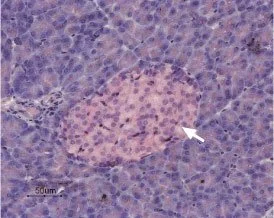
IHC-P analysis of rat pancreas tissue using GTX16647 KCNK5 antibody. Strong and highly specific staining is evident only in endocrine cells (arrow). ?Hematoxilin is used as the counterstain. Dilution : 1:50
KCNK5 antibody
GTX16647
ApplicationsWestern Blot, ImmunoHistoChemistry, ImmunoHistoChemistry Paraffin
Product group Antibodies
ReactivityHuman, Mouse, Rat
TargetKCNK5
Overview
- SupplierGeneTex
- Product NameKCNK5 antibody
- Delivery Days Customer7
- ApplicationsWestern Blot, ImmunoHistoChemistry, ImmunoHistoChemistry Paraffin
- CertificationResearch Use Only
- ClonalityPolyclonal
- Concentration0.3 mg/ml
- ConjugateUnconjugated
- Gene ID8645
- Target nameKCNK5
- Target descriptionpotassium two pore domain channel subfamily K member 5
- Target synonymsacid-sensitive potassium channel protein TASK-2; K2p5.1; K2P5.1 potassium channel; KCNK5b; potassium channel subfamily K member 5; potassium channel, subfamily K, member 1 (TASK-2); potassium channel, subfamily, member 5 (KCNK5); potassium channel, two pore domain subfamily K, member 5; TASK2; TASK-2; TWIK-related acid-sensitive K(+) channel 2; TWIK-related acid-sensitive K+ 2; TWIK-related acid-sensitive K+ channel 2
- HostRabbit
- IsotypeIgG
- Protein IDO95279
- Protein NamePotassium channel subfamily K member 5
- Scientific DescriptionThis gene encodes one of the members of the superfamily of potassium channel proteins containing two pore-forming P domains. The message for this gene is mainly expressed in the cortical distal tubules and collecting ducts of the kidney. The protein is highly sensitive to external pH and this, in combination with its expression pattern, suggests it may play an important role in renal potassium transport. [provided by RefSeq, Jul 2008]
- ReactivityHuman, Mouse, Rat
- Storage Instruction-20°C or -80°C,2°C to 8°C
- UNSPSC12352203

